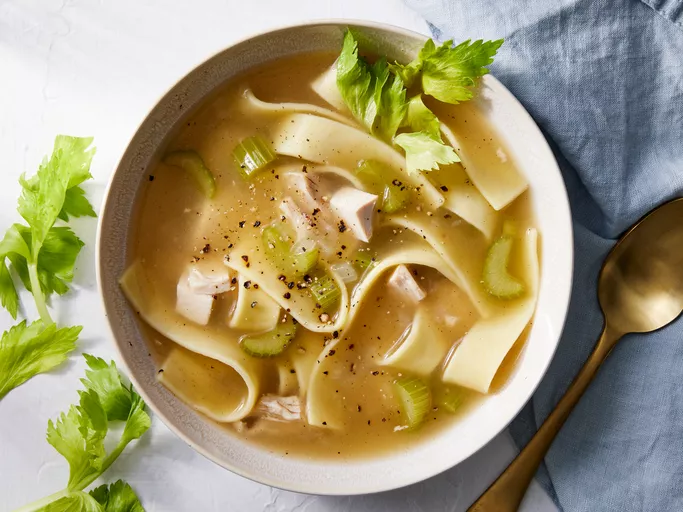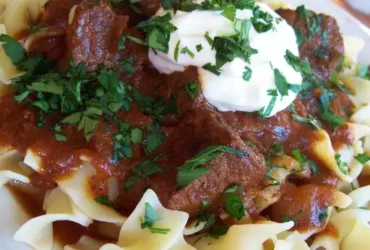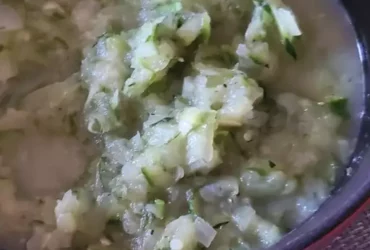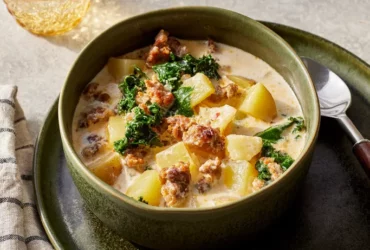Classic Ingredients
Chickens, Not Chick-Nuggets
The art of cooking a classic dish like Grandma’s Chicken Noodle Soup is not just about throwing together some ingredients, but rather about using traditional and high-quality components to create a truly comforting meal.
Classic Ingredients
This recipe calls for some essential elements that are sure to bring out the flavors and textures of the soup:
Creamy Chicken Broth
The base of this soup is a rich and savory chicken broth, made with slow-cooked bones and plenty of aromatic vegetables. This sets the stage for a hearty and satisfying meal.
Chickens Not Chick-Nuggets
Fresh or Pasture-Raised Chicken: Using high-quality chicken breast or thighs is crucial in this recipe, as it provides a tender and juicy texture that’s hard to replicate with lower-grade meat. Opt for fresh or pasture-raised options whenever possible.
Homemade Egg Noodles
Noodle-making is an art form, but don’t worry if you’re not a pro – making your own egg noodles from scratch can be a fun and rewarding process that adds depth to the dish. The best part? You get to control the quality and ingredients of the noodles.
Other notable ingredients in this recipe include sautéed onions, celery, carrots, thyme, and bay leaves – each adding their own unique flavor profiles to create a richly textured soup.
Preparing Classic Ingredients
Before we dive into the cooking process, make sure you’ve got all your classic ingredients prepped and ready to go:
- Cut chicken breasts or thighs into bite-sized pieces: You want these to be easy to cook through, but not so small that they’re lost in the soup.
- Mince aromatics like onions, celery, and carrots: These will add a depth of flavor to your broth, so make sure you chop them finely enough to distribute evenly throughout the soup.
- Cook egg noodles according to package instructions or make your own from scratch:If using store-bought noodles, follow the package instructions. If making your own, cook for about 3-5 minutes in boiling water before draining and setting aside.
Now that you’ve got all your classic ingredients prepped, let’s move on to cooking Grandma’s Chicken Noodle Soup like a pro!
Use whole chickens instead of chicken nuggets or processed meat for a richer flavor
When it comes to creating a delicious and authentic version of Grandma’s Chicken Noodle Soup, using classic ingredients is essential for achieving that rich and comforting flavor that this dish is known for.
One of the most important decisions you’ll make when preparing this recipe is whether to use whole chickens or chicken nuggets or processed meat. While convenience may be tempting, opting for whole chickens is a game-changer in terms of flavor and texture.
Whole chickens provide a depth of flavor that simply cannot be replicated with processed meats. The slow-cooking process breaks down the collagen, releasing all those lovely gelatinous bits into the broth, making it incredibly rich and satisfying.
The use of whole chickens also means you’ll get to enjoy the benefit of using every part of the bird – from the juicy meat to the flavorful skin and bones. This is where the magic happens in terms of flavor extraction, so don’t be afraid to get a little messy and make the most of your ingredients.
Additionally, when using whole chickens, you can choose to roast them before simmering them in the broth, which will add an extra layer of depth to your soup. The Maillard reaction – the chemical reaction between amino acids and reducing sugars that occurs when food is cooked – creates a rich, caramelized crust on the outside of the chicken, infusing the broth with even more flavor.
By choosing whole chickens over processed meats, you’ll not only be treating your family to a more authentic taste experience but also doing your part in promoting sustainable and responsible food practices. And let’s face it – who doesn’t love the idea of cooking up a nourishing meal from scratch using real, honest ingredients?
So there you have it – using whole chickens is the key to unlocking the full potential of Grandma’s Chicken Noodle Soup Recipe. With these simple yet effective tips and tricks, you’ll be well on your way to creating a dish that will warm hearts and bellies alike for generations to come.
Fresh vegetables are essential: onions, carrots, celery, and sometimes garlic
In Grandma’s Chicken Noodle Soup Recipe, classic ingredients play a crucial role in creating a rich and flavorful broth.
The foundation of this recipe lies in using fresh vegetables that are rich in flavor and nutrients. Some essential elements include:
- Onions: Sautéed onions add a depth of flavor to the soup, while also providing a hint of sweetness. They’re typically caramelized before being added to the pot.
- Celery: This crunchy vegetable adds texture and freshness to the soup. It’s commonly used in combination with onions and sometimes garlic to create a mirepoix.
- Carrots: Grated or sliced carrots bring a pop of color and natural sweetness to the soup. They’re also rich in vitamins and minerals that support immune function.
- Garlic: Although sometimes omitted, garlic adds a pungent flavor that enhances the overall taste of the soup. It’s usually minced or crushed before being added to the pot.
The combination of these ingredients creates a flavorful base for the chicken noodle soup. As you simmer the broth, the flavors meld together, and the fresh vegetables contribute to a healthy and satisfying meal.
Noodles: traditional egg noodles or rice noodles
When it comes to creating a delicious and authentic Grandma’s Chicken Noodle Soup, the choice of noodles is crucial.
Here are some classic ingredients that are commonly used in traditional recipes:
- Egg Noodles: These are a staple in many American kitchens, especially when it comes to comforting soups like chicken noodle soup. They’re made from wheat flour, eggs, and water, giving them a rich, yellow color and a slightly chewy texture.
- Rice Noodles: Also known as rice vermicelli or cellophane noodles, these are popular in many Asian cuisines, including Chinese, Vietnamese, and Thai. They’re made from rice flour and water, giving them a clear appearance and a delicate flavor.
- Wheat Noodles: These are similar to egg noodles but often have a slightly different texture and flavor profile. They’re popular in many Asian cuisines, especially in Chinese and Japanese cooking.
- Udon Noodles: These are thick, white wheat flour noodles that originated in Japan. They’re often served in hot broth or with dipping sauce, making them a great choice for chicken noodle soup.
The key to using classic ingredients is to choose the right type of noodle based on personal preference and the flavor profile you want to achieve. For example:
- Choose egg noodles for a rich, comforting soup with a slightly chewy texture.
- Choose rice noodles for a light, delicate soup with a clear broth and a hint of Asian flavors.
- Choose wheat noodles for a hearty, savory soup with a nutty flavor profile.
- Choose udon noodles for a thick, comforting soup with a rich, slightly sweet flavor.
Remember, the type of noodle you choose will greatly impact the flavor and texture of your Grandma’s Chicken Noodle Soup recipe. Experiment with different types to find the one that works best for you!
The Perfect Broth
Aromatics Matter
The foundation of any exceptional soup, including Grandma’s Chicken Noodle Soup, lies in its broth. A good broth can elevate even the most basic ingredients into a hearty and comforting meal.
Aromatics play a pivotal role in creating the perfect broth. They add depth, complexity, and an unparalleled richness to the liquid. The choice of aromatics is crucial; some common options include carrots, celery, onions, garlic, ginger, leeks, and shallots.
Onions are particularly significant in this context. They contain a high concentration of sulfur compounds, which are responsible for the characteristic flavor and aroma of cooked onions. When sautéed or caramelized, these compounds break down, releasing a sweet and savory flavor that enhances the overall broth.
Celery is another fundamental component in Grandma’s Chicken Noodle Soup Recipe. Its mild flavor allows it to blend seamlessly with other ingredients, while its high water content helps maintain the liquid’s viscosity. The pungency of celery seed also adds a unique and subtle note to the broth.
Ginger is a popular aromatic in many cuisines, including Asian and Indian cooking. It contains compounds that aid digestion and reduce inflammation, making it an excellent addition to any soup. When grated or sliced thinly, ginger can be added directly to the pot for an intense flavor experience.
Carrots are often overlooked but contribute significantly to a rich broth. They contain beta-carotene, which converts into vitamin A in the body, essential for healthy vision and immune function. In addition, their sweetness helps balance out the savory flavors of other ingredients.
Garlic is another staple aromatic in many recipes, including Grandma’s Chicken Noodle Soup. Its potent flavor requires careful handling: sauté it lightly to preserve its health benefits and flavor profile.
When combining these aromatics, remember that each ingredient should be cooked separately before adding them to the pot. This ensures they release their full flavor potential without overpowering one another. Start with the hardest ingredients – carrots, celery, onions, and garlic – then add softer items like ginger and leeks towards the end of cooking time.
For Grandma’s Chicken Noodle Soup Recipe, start by sautéing aromatics in a mixture of oil or butter until tender, then add the chicken and noodles according to your preference. A pinch of salt and pepper enhances flavors as they meld together during cooking time. By mastering the art of aromatics, you’ll unlock a depth of flavor that will make Grandma’s Chicken Noodle Soup an unbeatable comfort food classic.
Key Tips for Aromatics:
- Use a combination of at least three different aromatic vegetables or herbs to create the perfect blend of flavors and textures.
- Don’t overcook your aromatics, as this can lead to an unbalanced flavor profile. Sauté them until tender but still retaining their texture and essence.
- Prioritize onions as they are a fundamental component in most soups, including Grandma’s Chicken Noodle Soup Recipe.
- Add aromatics strategically, starting with harder ingredients and finishing with softer ones to ensure balanced flavors.
A well-balanced broth is the foundation of an exceptional soup. By incorporating a harmonious blend of aromatics, you’ll unlock unparalleled flavor potential in Grandma’s Chicken Noodle Soup Recipe and other soups alike.
Saute aromatics in a mixture of butter and olive oil for depth of flavor
The Perfect Broth is the foundation upon which a truly exceptional Chicken Noodle Soup recipe is built.
To create this rich and savory broth, it’s essential to begin by sautéing aromatics in a mixture of butter and olive oil.
This combination provides depth of flavor that cannot be achieved with either ingredient alone. The butter adds a richness and velvety texture, while the olive oil brings a fruity and slightly bitter note to the dish.
Step 1: Saute Aromatics
- Select a mix of aromatics such as onions, carrots, celery, and herbs like thyme and rosemary.
- Mince or chop these ingredients finely to ensure even cooking and optimal flavor release.
- In a large pot, melt 2 tablespoons of butter over medium heat and swirl it to coat the bottom of the pan.
- Add 1 tablespoon of olive oil to the melted butter, stirring to combine.
Next, add the chopped aromatics to the pot and sauté for about 5-7 minutes or until they’re softened and fragrant.
Step 2: Add Liquid and Simmer
- Pour in 4 cups of chicken broth, making sure to cover the aromatics completely.
- Add 1 cup of water to dilute the broth slightly and achieve a lighter consistency.
Bring the mixture to a boil, then reduce the heat to low and simmer for at least 20-30 minutes or until the flavors have melded together beautifully.Throughout the cooking process, you can occasionally skim off any impurities that rise to the surface to maintain clarity in the broth.
Use chicken stock, preferably homemade, as the base of the soup
The Perfect Broth is the foundation of a truly exceptional chicken noodle soup, and for Grandma’s recipe, homemade chicken stock is the ideal choice.
This rich and savory liquid forms the base of the soup, providing an unparalleled depth of flavor that elevates every bite.
Why Homemade Chicken Stock?
The difference between store-bought stock and homemade is like night and day – it’s a distinction that can make or break a dish.
- Store-bought stock often contains preservatives, artificial flavor enhancers, and other additives that detract from the natural taste of the chicken.
- Homemade stock, on the other hand, is made with love, care, and high-quality ingredients – resulting in a broth that’s both nourishing and delicious.
The Art of Making Homemade Chicken Stock
Making homemade chicken stock requires some time, patience, and effort, but trust Grandma on this one – it’s worth every minute!
- Start by collecting high-quality chicken bones (you can use raw or cooked bones, depending on your preference).
- Add the chicken bones to a large pot and cover them with cold water – make sure they’re fully submerged.
- Bring the mixture to a boil, then reduce the heat to a simmer and let it cook for 12-24 hours (yes, you read that right – 12-24 hours!).
- Once the stock has cooled, strain it through a fine-mesh sieve into a clean pot or container.
The Result: A Perfect Broth for Grandma’s Chicken Noodle Soup Recipe
The end result of this process is a rich, velvety broth that’s packed with flavor and nutrients.
- A perfect base for Grandma’s chicken noodle soup recipe – add your favorite vegetables, noodles, and herbs to create a dish that’s sure to warm hearts and bellies alike!
Bay leaves add a subtle yet essential flavor element
The perfect broth is the foundation of any delicious and comforting soup, like Grandma’s Chicken Noodle Soup Recipe. It’s what elevates a simple combination of ingredients into a truly nourishing and satisfying meal.
To create the perfect broth, you need to focus on extracting the rich flavors from your ingredients while avoiding any harsh or bitter notes that can ruin the overall taste experience. One essential element in achieving this balance is the use of bay leaves.
Bay leaves add a subtle yet essential flavor element to the broth, which is often described as slightly sweet and herbal. This unique characteristic helps to round out the flavors and prevents the broth from becoming too acidic or one-dimensional.
The key to using bay leaves effectively is to introduce them at the right moment during cooking. Typically, you’ll want to add a few whole or bruised bay leaves to the pot early in the cooking process, allowing their fragrance and flavor to infuse into the broth over time.
For Grandma’s Chicken Noodle Soup Recipe, it’s recommended to add 2-3 bay leaves towards the beginning of the cooking time, along with the chicken bones and vegetables. This will enable the bay leaves to release their full potential without overpowering the other ingredients.
Another important consideration is not to overcook the bay leaves, as this can cause them to lose their potency and become unpleasantly bitter. Simply remove them from the pot after 30-40 minutes of simmering, or earlier if you’re using a pressure cooker.
By incorporating bay leaves into your broth and following Grandma’s tried-and-tested techniques, you’ll be well on your way to creating the perfect chicken noodle soup that warms hearts and satisfies appetites. So go ahead and give it a try – with a little patience and attention to detail, you can create a truly unforgettable culinary experience.
Family Heirloom Tips
Tradition is Key to Perfection
Family heirlooms are a treasured part of any family’s history, and when it comes to traditional recipes like Grandma’s Chicken Noodle Soup, they hold a special place in our hearts.
Tradition is indeed key to perfection in the kitchen, as it allows us to preserve the essence of our ancestors’ cooking methods and techniques that have been passed down through generations.
Here are some family heirloom tips for preserving Grandma’s Chicken Noodle Soup Recipe:
Preserve the Family Story
Along with the recipe, make sure to record the story behind it. This includes how your grandmother learned to cook, what inspired her, and any other interesting anecdotes related to the dish.
Pass Down the Ingredients
Identify the exact ingredients used in Grandma’s Chicken Noodle Soup Recipe, including their quality and quantity. This will help ensure that the recipe remains authentic even when it’s passed down to future generations.
Create a Family Cookbook
Gather all of your family’s treasured recipes and compile them into a single cookbook that can be cherished for years to come.
Additionally, here are some tips for keeping Grandma’s Chicken Noodle Soup Recipe alive:
- Make it Together: Invite your family members to cook the soup together, sharing stories and laughter as you go.
- Update It, But Respect Tradition: If you need to modify the recipe for modern tastes or dietary restrictions, do so in a way that stays true to the original intent of Grandma’s creation.
- Show Love and Care: When preparing and serving the soup, infuse it with love and care. This will make all the difference in the flavors and aromas.
Grandma’s recipe uses only water and no bouillon cubes or other shortcuts
When it comes to cooking with family heirlooms, there are several tips to keep in mind to preserve their integrity and authenticity. For instance, in the case of Grandma’s recipe for chicken noodle soup, it’s essential to use only traditional ingredients that have been passed down through generations.
One key aspect of this recipe is the use of water instead of bouillon cubes or other shortcuts. This may seem like a minor detail, but it actually makes a significant difference in the flavor and quality of the final dish. By using only water, Grandma’s recipe allows the natural flavors of the chicken and vegetables to shine through without any artificial additives or preservatives.
Another important aspect of cooking with family heirlooms is the importance of following tradition. In this case, that means making sure to use only traditional ingredients and methods that have been passed down through generations. This may include using fresh herbs, home-cooked broth, and handmade noodles.
To get started, you’ll need a few basic ingredients including chicken, vegetables, and some water. You can use any type of chicken you prefer, but Grandma’s recipe calls for boneless, skinless breasts or thighs. Cut the chicken into bite-sized pieces and set it aside for later use.
Next, peel and chop a variety of vegetables such as carrots, celery, and onions. These will add flavor, texture, and nutrients to the soup. You can also use other vegetables such as potatoes, peas, or corn if you prefer.
In a large pot, combine the chicken and vegetables along with enough water to cover everything. Bring the mixture to a boil over high heat, then reduce the heat to medium-low and simmer for 10-15 minutes, or until the chicken is cooked through.
While the soup is cooking, you can make the noodles according to Grandma’s recipe. This may involve mixing together flour, water, and egg to form a dough, which you’ll then roll out and cut into thin strips.
Once the noodles are ready, add them to the pot with the chicken and vegetables. Continue to simmer for another 5-10 minutes, or until the noodles are cooked through and the soup has reached your desired consistency.
To serve, ladle the hot soup into bowls and enjoy! You can garnish with fresh herbs such as parsley or thyme, and serve with a side of crusty bread or crackers if you like.
Simmer the soup slowly for at least an hour to extract all flavors from ingredients
When it comes to family heirloom recipes like Grandma’s Chicken Noodle Soup, every detail matters to preserve the tradition and love that goes into cooking for loved ones.
One essential tip when preparing this beloved soup is to simmer it slowly for at least an hour to extract all flavors from ingredients. This slow-cooking process allows the chicken, vegetables, and noodles to meld together in perfect harmony, creating a rich and comforting broth that warms the heart as much as the body.
Simmering the soup over low heat also enables the extraction of nutrients from the ingredients, making it a nutritious meal for all. The slow-cooking process breaks down the collagen in the chicken, making it tender and fall-off-the-bone easy to eat.
To take your Grandma’s Chicken Noodle Soup to the next level, consider using homemade noodles made with love and care. Freshly cooked noodles add an extra layer of texture and flavor to the soup, making it a truly special experience for those who taste it.
Another tip for preserving family heirloom recipes like this one is to document every step, from ingredient lists to cooking times. This ensures that future generations can continue to enjoy and perfect the recipe, even if you’re no longer around to share your secrets.
Finally, remember to cook with love and intention whenever preparing a family heirloom recipe. The love and care you put into cooking is what makes these recipes truly special, so take your time, be mindful of every detail, and enjoy the process as much as the end result.
By following these tips and passing down Grandma’s Chicken Noodle Soup Recipe to future generations, you’ll help keep family traditions alive and well for years to come.
Serve with fresh parsley or thyme for added freshness
In order to make Grandma’s Chicken Noodle Soup Recipe a family heirloom, it’s essential to follow some tips that will help preserve its authenticity and ensure it’s passed down for generations to come.
Here are some valuable tips to consider:
Store the recipe in a safe place
- Consider keeping it in a family recipe book or a designated binder
- Make sure to keep it away from heat and moisture
- Label the storage container clearly, indicating what’s inside
Pass down the recipe in person
- When passing down the recipe, have a family gathering or dinner where everyone can share their thoughts and memories associated with the soup
- Teach the younger generation how to make the soup from scratch, including the preparation of ingredients and cooking techniques
Document the recipe’s history and significance
- Create a written or video account of how the recipe was passed down, including any family stories and traditions associated with it
- Include photos of family members who have made the soup over the years
Add personal touches to make it your own
- Experiment with new ingredients or flavor combinations to create a unique twist on the original recipe
- Pass down your favorite serving suggestions, such as serving with fresh parsley or thyme for added freshness
Maintain the recipe’s authenticity
- Make sure to pass down the original recipe without any significant changes
- Encourage family members to stick to the traditional methods and ingredients when making the soup
Create a sense of community around the recipe
- Host family gatherings or dinner parties where everyone can come together to make and enjoy the soup
- Encourage family members to share their favorite memories associated with the soup
- Best Datanyze Alternatives for 2025 - April 24, 2025
- Best Hunter.io Alternatives for 2025 - April 22, 2025
- Best Lead411 Alternatives for 2025 - April 22, 2025















